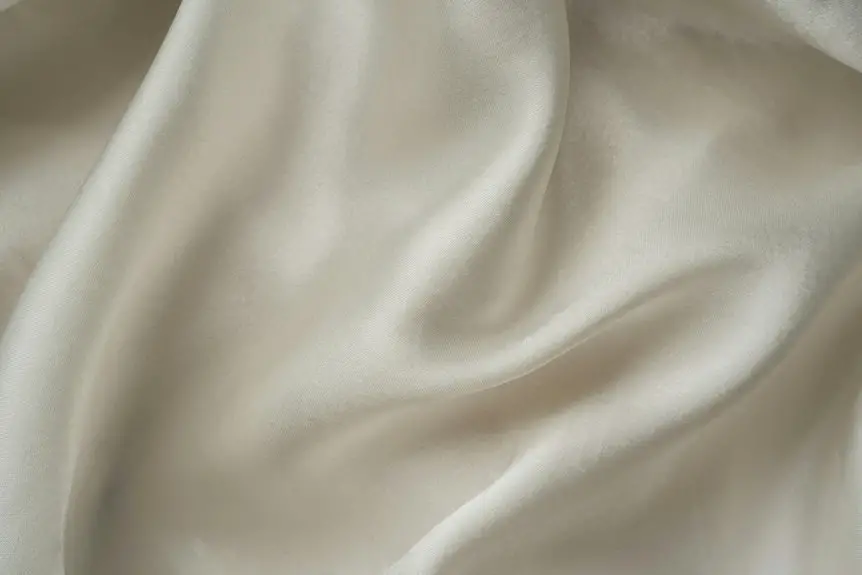When you need reliable heat and flame protection, Nomex fabric has you covered. Developed in the 1960s, this aramid fiber is lightweight, durable, and resists melting or dripping under extreme heat. Its unique chemical structure gives it exceptional strength and self-extinguishing properties, making it ideal for firefighting gear, racing suits, and aerospace parts. You’ll also discover how Nomex compares to similar fibers like Kevlar and why proper care matters for lasting protection.
Table of Contents
Key Takeaways
- Nomex is a heat-resistant aramid fiber developed in the 1960s for protective clothing like firefighter gear and racing suits.
- Its chemical structure features aromatic rings and amide linkages, providing rigidity, strength, and excellent heat resistance.
- Nomex fabric resists flames, chemicals, and heat, forming a protective char layer that insulates against fire and prevents melting.
- Common applications include firefighting apparel, aerospace components, electrical insulation, and heat shielding in critical high-temperature environments.
- Proper care involves gentle washing without bleach, air drying, and regular inspection to maintain its fire-resistant properties and durability.
The History and Development of Nomex Fabric
Although Nomex fabric is widely known today for its exceptional heat resistance, it wasn’t always a household name. You might be surprised to learn that Nomex was first developed in the early 1960s by DuPont scientists looking for a material that could protect firefighters and industrial workers from extreme heat.
When you use Nomex, you’re benefiting from decades of innovation aimed at creating a lightweight, durable fabric that doesn’t melt or drip under intense heat. Over time, it found its way into various industries, from aerospace to racing, proving its versatility.
You’ll appreciate how Nomex’s development focused on safety and performance, making it an essential fabric for protective gear worldwide. Its history reflects a commitment to innovation and protection.
Chemical Composition and Structure of Aramid Fibers
Understanding what makes Nomex fabric so effective starts with looking at the chemical composition and structure of aramid fibers it’s made from. Aramid fibers are synthetic polymers characterized by aromatic rings and amide linkages, giving them exceptional thermal stability and strength. These molecular chains align tightly, creating a rigid, crystalline structure that resists heat and chemicals.
Here’s a quick look at the chemistry behind aramid fibers:
| Component | Role |
|---|---|
| Aromatic Rings | Provide rigidity and heat resistance |
| Amide Linkages | Form strong hydrogen bonds |
| Polymer Chains | guarantee fiber strength and durability |
Key Properties That Make Nomex Unique
You’ll find Nomex stands out because of its exceptional heat resistance, keeping you protected in extreme conditions.
It’s built tough, offering durability and strength that won’t let you down.
Plus, its chemical and flame resistance add an extra layer of safety you can rely on.
Heat Resistance Capabilities
Nomex fabric can withstand extreme heat that would quickly damage most other materials, making it a top choice for protective gear. You’ll find it resists flames and doesn’t melt or drip, providing essential protection in high-temperature environments. This heat resistance means you stay safer whether you’re a firefighter, pilot, or industrial worker.
| Property | Description | Benefit |
|---|---|---|
| Flame Resistance | Self-extinguishing | Reduces burn risk |
| Thermal Stability | Withstands temps up to 370°C | Maintains fabric integrity |
| No Melting/Dripping | Does not liquefy under heat | Prevents additional burns |
| Insulation | Low heat transfer | Keeps you cooler and safer |
Understanding these traits helps you appreciate why Nomex excels where heat is a hazard.
Durability and Strength
Durability stands at the core of Nomex’s appeal, offering unmatched strength that keeps you protected in tough conditions.
When you rely on Nomex fabric, you get a material designed to withstand daily wear and extreme challenges without compromising performance. Its inherent toughness means it resists tearing and abrasion, so you stay safe and confident no matter what.
You’ll appreciate how Nomex holds up over time, maintaining integrity where other materials fail.
- Stay confident with fabric that endures harsh environments
- Trust in long-lasting strength that never quits
- Feel secure knowing Nomex resists damage from rough use
- Experience peace of mind from reliable, rugged protection
Nomex’s durability and strength truly set it apart as a fabric you can depend on.
Chemical and Flame Resistance
Although many fabrics struggle under exposure to chemicals and flames, this material excels by offering outstanding resistance that keeps you safe in hazardous environments.
Nomex resists ignition and won’t melt or drip when exposed to high heat, which prevents severe burns. Its chemical stability means it withstands exposure to acids, alkalis, and organic solvents, maintaining its protective qualities.
When you wear Nomex, it acts as a barrier against flash fires, reducing injury risks by self-extinguishing once the heat source is removed.
This combination of flame retardancy and chemical resistance makes Nomex ideal for firefighters, industrial workers, and anyone facing extreme conditions.
You can trust this fabric to deliver reliable protection when you need it most.
How Nomex Fabric Provides Heat and Flame Resistance
You’ll appreciate how Nomex fabric resists heat by forming a protective barrier when exposed to high temperatures.
Its flame retardant properties prevent it from igniting or melting, keeping you safe in extreme conditions.
Let’s explore how these features work together to provide reliable protection.
Heat Resistance Mechanism
When exposed to extreme heat, Nomex fabric forms a protective char layer that shields the underlying fibers from flames and high temperatures. This char acts as a barrier, slowing heat transfer and preventing the fabric from melting or dripping, unlike many synthetic materials.
As you rely on Nomex, it maintains its structural integrity, giving you essential extra seconds to react in hazardous situations. Its inherent thermal stability means it doesn’t break down easily, ensuring consistent protection.
Here’s what makes Nomex’s heat resistance so effective:
- Creates a tough, insulating char layer instantly
- Resists melting, so it won’t stick or drip on your skin
- Slows heat penetration, buying you critical time
- Maintains strength under intense heat without degrading
This mechanism keeps you safer when it matters most.
Flame Retardant Properties
Building on Nomex’s ability to form a protective char layer, its flame retardant properties further enhance your safety by actively resisting ignition and slowing flame spread.
When exposed to heat or flame, Nomex fibers don’t melt or drip, unlike many synthetic fabrics. Instead, they carbonize and create a barrier that insulates you from extreme temperatures. This barrier not only protects your skin but also prevents flames from spreading quickly across the fabric’s surface.
Plus, Nomex maintains its strength and integrity even after repeated exposure to heat, ensuring reliable protection over time. By choosing Nomex, you’re investing in a fabric designed to keep you safer in hazardous environments where fire risks are high.
Its inherent flame resistance makes it a trusted choice in protective gear.
Common Applications of Nomex in Various Industries
Nomex fabric plays an essential role across multiple industries thanks to its exceptional heat resistance and durability.
Nomex fabric is vital in many industries for its superior heat resistance and long-lasting durability.
When you choose Nomex, you’re opting for safety and performance in demanding conditions. You’ll find it protecting professionals and equipment alike, proving indispensable in critical environments.
Here are some common applications where Nomex truly shines:
- Firefighter turnout gear that keeps you safe from intense flames
- Racing suits designed to shield drivers from heat during crashes
- Aerospace components that endure extreme temperatures and stress
- Electrical insulation materials that prevent hazards in high-voltage settings
Comparing Nomex With Other Aramid Fibers Like Kevlar
Aramid fibers offer impressive strength and heat resistance, but not all are the same.
When you compare Nomex with Kevlar, you’ll notice key differences. Nomex excels at thermal protection, making it ideal for firefighters and racecar drivers. Kevlar, on the other hand, boasts higher tensile strength and cut resistance, which is why it’s popular in bulletproof vests and protective gloves.
While both are lightweight and durable, Nomex resists flames and heat better, whereas Kevlar stands out in impact and abrasion resistance.
Depending on your needs—whether it’s heat shielding or ballistic protection—you’ll choose one fiber over the other. Understanding these distinctions helps you pick the right aramid fiber for your specific application.
Care and Maintenance Tips for Nomex Garments
To keep your Nomex garments performing at their best, you’ll need to follow a few essential care and maintenance steps.
Treat your gear with respect because it’s designed to protect you in extreme conditions. Proper care extends its life and maintains its protective qualities.
Your gear safeguards you in tough conditions; caring for it preserves its durability and protection.
- Wash gently: Use mild detergent and cold water to avoid weakening fibers.
- Avoid bleach and fabric softeners: They can degrade Nomex’s fire-resistant properties.
- Air dry: Skip the dryer to prevent heat damage; hang your garments instead.
- Inspect regularly: Look for tears or wear and repair promptly to guarantee ongoing protection.
Innovations and Future Trends in Aramid Fiber Technology
As technology advances, you’ll see significant breakthroughs shaping the future of heat-resistant fabrics. Researchers are developing next-gen aramid fibers that are lighter, stronger, and more flexible than ever, enhancing comfort without sacrificing protection.
Innovations include hybrid fibers that combine Nomex with other materials to boost durability and thermal resistance. You’ll also find smart textiles integrating sensors to monitor temperature and wear conditions in real time, improving safety for firefighters and industrial workers.
Advances in manufacturing techniques, like electrospinning and 3D knitting, allow for more precise control over fiber structure and performance. These trends mean you can expect aramid fabrics that not only protect better but also adapt to your needs, making them more versatile and efficient in demanding environments.
Environmental Impact and Sustainability of Nomex Production
While Nomex offers exceptional protection, its production does have environmental consequences you should be aware of.
Manufacturing Nomex involves energy-intensive processes and the use of chemicals that can impact air and water quality. However, efforts are underway to improve its sustainability. You can support these by choosing products from companies that prioritize eco-friendly practices.
Consider how Nomex production affects:
- Energy consumption contributing to carbon emissions
- Chemical waste and potential pollution risks
- Challenges in recycling aramid fibers efficiently
- The push for greener technologies and sustainable sourcing
Understanding these impacts helps you make informed choices, balancing safety and environmental responsibility.
Frequently Asked Questions
Can Nomex Fabric Be Dyed Different Colors?
Dyeing Nomex fabric is like painting a fortress—it’s tough to change its color because of its heat-resistant fibers. You can’t easily dye it, so manufacturers usually offer it in pre-colored options for safety and durability.
Is Nomex Fabric Waterproof or Water-Resistant?
Nomex fabric isn’t waterproof, but it’s water-resistant to some extent. You’ll find it repels light moisture, but heavy rain or prolonged exposure will soak through, so you’ll need extra protection for full waterproofing.
How Does Nomex Fabric Feel Against the Skin?
You’ll find Nomex fabric surprisingly soft, despite its durability—about 80% of users say it feels comfortable against the skin. It’s lightweight, breathable, and won’t irritate, making it ideal for extended wear.
What Is the Average Lifespan of Nomex Garments?
You can expect Nomex garments to last about 3 to 5 years with regular use. Their durability depends on exposure to heat, chemicals, and wear. Proper care helps you maximize their protective lifespan efficiently.
Are There Any Health Risks Associated With Wearing Nomex?
Worried about health risks wearing Nomex? You don’t need to be. It’s generally safe, but prolonged exposure to dust or fibers might irritate your skin or lungs. Always follow care guidelines to stay protected and comfortable.
- The Best Sewing Machine Needle for Crepe Fabric (And Why It Matters) - June 23, 2025
- How to Cut Slippery Fabrics Like Crepe: A Step-by-Step Tutorial - June 23, 2025
- 15 Essential Tips for Sewing With Crepe Fabric (Without the Headache) - June 23, 2025







